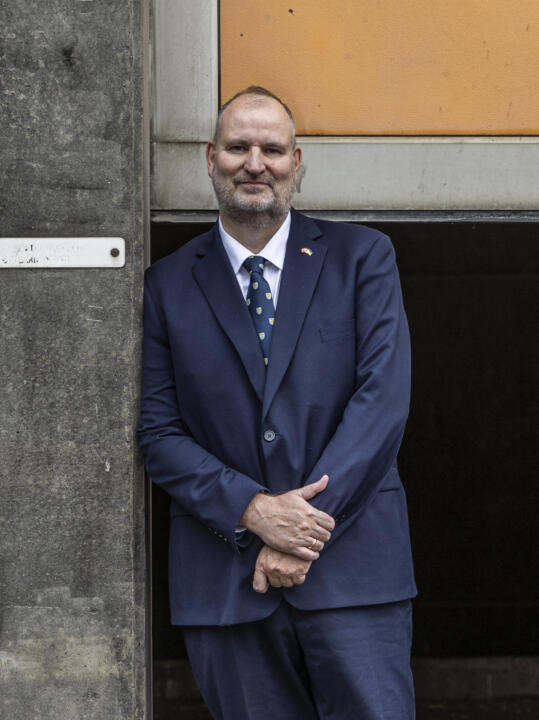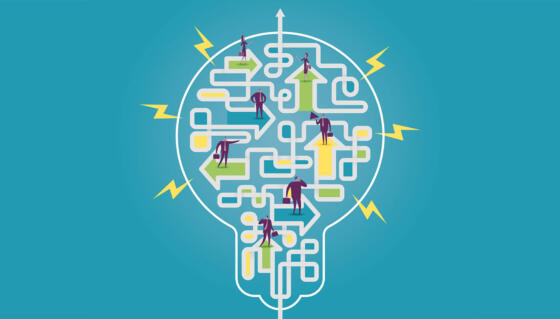On the way to Cleanland
At some point in time in late 2017, early 2018, the countdown began in Bornholm. It was the time at which Jens Hjul-Nielsen started thinking about the future of his company, slowly seeing the end of his currently used technology dawning on the horizon – and calling for capital expenditures. However, Hjul-Nielsen isn’t the CEO of just any small island business. He’s responsible for BOFA, which stands for “Bornholms Affaldsbehandling,” in other words the island’s central waste disposal company.
That his incinerators would have to be replaced in 2032 increasingly caused him discomfort. “Although since the early 1970s waste incineration was a solution that worked,” he explains, “it can’t be a sustainable solution because it produces way too much CO₂, ash, and slag. But if we built a new plant in 2032,” was a thought that crossed his mind, “we’d be stuck in a technological lock-in for the next 20, 30 years.” To prevent that, Hjul-Nielsen decided to pursue a radically different approach: shutting down the incinerators and reusing the waste as a resource instead of blowing it through the chimney.

The quest for new ideas and technologies
However, it was perfectly clear to him that fundamental changes like those could only work out in a joint effort with everyone concerned. In several meetings, Hjul-Nielsen initially convinced his team. “At first, people were very skeptical,” he recalls, “but slowly all of them did come on board.” Seeing the heaps of garbage simply disappear in the incinerator day in day out opened the eyes of those concerned for the urgency of change.
“To get ideas for the coming 14 years, we reviewed the past 14 years in terms of innovations that we might be able to develop further. That made it clear that we’d have to significantly intensify the rate of innovations,” Hjul-Nielsen says with a view toward the establishment of a functioning circular economy and the new ideas, concepts, and collaborative partnerships that requires.
But first the revolutionary concept had to be pushed through politically. “Bornholm has a big advantage,” explains David Andreas Mana-Ay Christensen, who is responsible for new concepts and projects at BOFA and has long become Hjul-Nielsen’s right arm in the company’s transformation. “Islands without a permanent land connection – in other words without a bridge or causeway – enjoy greater autonomous space than the rest of Denmark. That’s why our waste incineration had not been privatized, which now gave us the necessary scope for new concepts.” Six months after the employees, the island’s political community was brought into the loop of the vision. Hjul-Nielsen recalls, “They adopted the idea in a unanimous vote. As a result, our project gained planning certainty and, in the future, will not be jeopardized either by potential changes in the political balance of power after elections.”
Even before the zero-waste vision could be launched on the island itself, Hjul-Nielsen and his team additionally presented the concept to a parliamentary committee in Copenhagen. It met with great interest. “We must have sounded reasonably convincing,” the BOFA CEO says with a twinkle in his eye, “because shortly afterwards, the parliament decided to reduce waste incineration in the whole country by 30 percent by 2030.”
So, the project was backed on all important political levels. Now the time had come for the practical part – an island of waste destroyers had to be turned into an island of waste savers. “Waste is a fundamentally wrong concept. It declares a product to be completely useless just because it no longer performs its main function. It’s scrapped, discarded, and deposited in a land fill or incinerated, and in that process, the resources installed in the product are lost. However, if you communicate to consumers the value that’s still contained in a product that has become superficially useless that illustrates the necessity as well as the opportunity to preserve its value and to keep using it in the future by handling it correctly,” Mana-Ay Christensen can convincingly explain this over and over like a mantra. An island-wide poll produced backing for the zero-waste idea. More than 55 percent of the island’s population supported the new objective, some 30 percent had a neutral opinion about it, and around 15 percent opposed it.
New ways and no fear of dead-end streets
The zero-waste vision sounds like a finished concept but Hjul-Nielsen is honest. “We don’t know ourselves exactly what must be done in detail and where the solutions for new problems that will undoubtedly emerge will lie. We’re conducting a huge experiment here that will only pan out together with the island’s population, the businesses, and the political community.” In addition to the consistent separation of waste into several fractions, comprehensive composting of organic waste, and opportunities for repairing defective devices, it includes an island-wide online swap-meet for discarded yet still usable items.

“We invite all individuals and companies, nationally as well as internationally, to collaborate with us here and to try out new things.”
All that doesn’t sound so exciting and new – and it isn’t. New, though, is the fact that Bornholm wants to – and must – implement all the necessary changes and actions as a package and coordinated with each other because the expiration date of the current incinerators specifies an unshakable final date for changing the waste concept. Initial steps have been taken: In 2018, of 83,770 metric tons (92,340 short tons) of waste, 66.3 percent were recycled, 25.2 percent incinerated, and 8.5 disposed of in landfills in Bornholm – in 2023, the waste had decreased to 80,150 metric tons (88,350 short tons) of which 71.5 percent were recycled, 22.6 percent were incinerated, and 5.9 percent disposed of in landfills. Reducing the two latter statistics to zero will be tough. The people in Bornholm are clear about that.
David Mana-Ay Christensen views this as a sporting challenge: “In front of us is uncharted territory and we even need to first build the road that’s supposed to take us through it. But exactly that is the challenge.” His boss seconds, “When you want to walk through the woods you can either follow wide paths and arrive where everyone else is already located. But if you try out new paths you may end up in dead-end streets or get stuck in the thicket and need to take some unexpected detours. But that’s the only way in which you can hit upon all-new solutions and ideas.”
“Zero waste” global
The statistics are alarming: By 2050, the amount of annual waste worldwide could grow from 2.24 to 3.88 billion metric tons (2.5 to 4.3 billion short tons), according to the UN. Especially worrisome is the fact that only 55 % of the current trash mountains are disposed of in appropriate facilities, the rest is disposed of elsewhere, e.g., 37 million metric tons (41 million short tons) of plastic waste in the oceans every year. However, there are some positive signals as well. For instance, more than 550 cities and municipalities worldwide in the Zero Waste International Alliance (zwia.org) have committed to the goal of drastically reducing the amount of waste they generate and to reroute waste to a circular economy. In the EU, the Zero Waste Cities (zerowastecities.eu) alliance pursues the same goal. Many of the cities and municipalities engaged in that program can show remarkable success on the zero-waste journey:
- Between 2011 and today, the Sicilian municipality of Calatafimi Segesta has roughly doubled its waste separation rate from 42.7 to more than 85 %.
- Since 2012, Milan has been encouraging its 1.4 million inhabitants to separately dispose of organic waste. Today, the North-Italian metropolis with a per capita amount of 95 kg (209 lbs.) of green waste is a global pioneer.
- The German university city of Tübingen introduced a tax on some forms of disposable packaging. One of the consequences was a 15-percent reduction of waste deposited in public collection bins.
- Within one decade, Slovenia’s capital Ljubljana reduced its entire amount of waste by 15 %, the average of recycled or composted waste increased to 61 %, and the amount of waste disposed of in landfills decreased by 59 %.
In addition to technological innovations yet to discover, information is a vital part of the program. “Before the year is out, we’re going to roll out extended waste separation in the households, and in 2025, businesspeople and companies on the island with new solutions for commercial waste will be the focus,” Mana-Ay Christensen says, outlining some of the key actions. “Plus, we’re educating people, especially children. At the visitors’ center, we jointly take old smartphones apart and explain what things in them could continue to be used. Just like with a Lego object whose pieces can be used again in different ways. Any child here understands that because Lego, after all, is from Denmark.”
Yet BOFA cannot and, as the company has said, does not want to tackle the new way of handling waste as a resource on its own. “The island is like a laboratory with 40,000 people, normal citizens, we’re not an eco-island. That’s why we invite all individuals and companies, nationally as well as internationally, to collaborate with us here and to try out new things. What works with 40,000 people can also work with 400,000 people or even with many more,” says Hjul-Nielsen, summarizing the situation.
By 2032 Bornholm is planning to have maneuvered itself out of its destructive disposal dead-end street. It may sound absurd but that’s when some of the things that today are incinerated as garbage will even leave the island again, albeit not as useless waste but as valuable, because optimally processed, substances for further use in new products.




